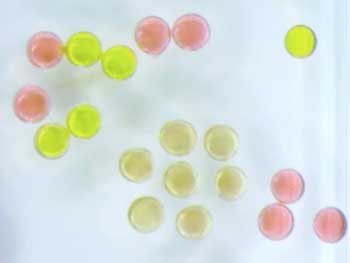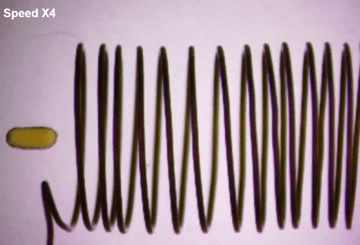| Jul 19, 2019 | |
New laws of attraction: Scientists print magnetic liquid droplets(Nanowerk News) Inventors of centuries past and scientists of today have found ingenious ways to make our lives better with magnets – from the magnetic needle on a compass to magnetic data storage devices and even MRI body scan machines. |
|
| All of these technologies rely on magnets made from solid materials. But what if you could make a magnetic device out of liquids? Using a modified 3D printer, a team of scientists at the Department of Energy’s Lawrence Berkeley National Laboratory (Berkeley Lab) have done just that. | |
| Their findings, published in the journal Science ("Reconfigurable ferromagnetic liquid droplets"), could lead to a revolutionary class of printable liquid devices for a variety of applications – from artificial cells that deliver targeted cancer therapies to flexible liquid robots that can change their shape to adapt to their surroundings. | |
| “We’ve made a new material that is both liquid and magnetic. No one has ever observed this before,” said Tom Russell, a visiting faculty scientist at Berkeley Lab and professor of polymer science and engineering at the University of Massachusetts, Amherst, who led the study. “This opens the door to a new area of science in magnetic soft matter.” | |
| For the past seven years, Russell, who leads a program called Adaptive Interfacial Assemblies Towards Structuring Liquids in Berkeley Lab’s Materials Sciences Division and also led the current study, has focused on developing a new class of materials – 3D-printable all-liquid structures. | |
| Russell and Xubo Liu, the study’s lead author, came up with the idea of forming liquid structures from ferrofluids, which are solutions of iron-oxide particles that become strongly magnetic in the presence of another magnet. “We wondered, ‘If a ferrofluid can become temporarily magnetic, what could we do to make it permanently magnetic, and behave like a solid magnet but still look and feel like a liquid?’” said Russell. | |
Jam sessions: making magnets out of liquids |
|
| To find out, Russell and Liu used a 3D-printing technique ("Scientists 3D-print all-liquid lab-on-a-chip") they had developed with former postdoctoral researcher Joe Forth in Berkeley Lab’s Materials Sciences Division to print 1 millimeter droplets from a ferrofluid solution containing iron-oxide nanoparticles just 20 nanometers in diameter (the average size of an antibody protein). | |
| Using surface chemistry and sophisticated atomic force microscopy techniques, staff scientists Paul Ashby and Brett Helms of Berkeley Lab’s Molecular Foundry revealed that the nanoparticles formed a solid-like shell at the interface between the two liquids through a phenomenon called “interfacial jamming.” This causes the nanoparticles to crowd at the droplet’s surface, “like the walls coming together in a small room jampacked with people,” said Russell. | |
 |
|
| Array of 1 millimeter magnetic droplets: Fluorescent green droplets are paramagnetic without any jammed nanoparticles at the liquid interface; red are paramagnetic with nonmagnetic nanoparticles jammed at the interface; brown droplets are ferromagnetic with magnetic nanoparticles jammed at the interface. (Image: Xubo Liu et al./Berkeley Lab) | |
| To make them magnetic, the scientists placed the droplets by a magnetic coil in solution. As expected, the magnetic coil pulled the iron-oxide nanoparticles toward it. | |
| But when they removed the magnetic coil, something quite unexpected happened. | |
| Like synchronized swimmers, the droplets gravitated toward each other in perfect unison, forming an elegant swirl “like little dancing droplets,” said Liu, who is a graduate student researcher in Berkeley Lab’s Materials Sciences Division and a doctoral student at the Beijing University of Chemical Technology. | |
| Somehow, these droplets had become permanently magnetic. “We almost couldn’t believe it,” said Russell. “Before our study, people always assumed that permanent magnets could only be made from solids.” | |
Measure by measure, it’s still a magnet |
|
| All magnets, no matter how big or small, have a north pole and a south pole. Opposite poles are attracted to each other, while the same poles repel each other. | |
| Through magnetometry measurements, the scientists found that when they placed a magnetic field by a droplet, all of the nanoparticles’ north-south poles, from the 70 billion iron-oxide nanoparticles floating around in the droplet to the 1 billion nanoparticles on the droplet’s surface, responded in unison, just like a solid magnet. | |
| Key to this finding were the iron-oxide nanoparticles jamming tightly together at the droplet’s surface. With just 8 nanometers between each of the billion nanoparticles, together they created a solid surface around each liquid droplet. | |
| Somehow, when the jammed nanoparticles on the surface are magnetized, they transfer this magnetic orientation to the particles swimming around in the core, and the entire droplet becomes permanently magnetic – just like a solid, Russell and Liu explained. | |
| The researchers also found that the droplet’s magnetic properties were preserved even if they divided a droplet into smaller, thinner droplets about the size of a human hair, added Russell. | |
 |
|
| To make the iron-oxide nanoparticles permanently magnetic, the scientists placed the droplets by a magnetic coil in solution. As expected, the magnetic coil pulled the iron-oxide nanoparticles toward it. (Image: Xubo Liu et al./Berkeley Lab) | |
| Among the magnetic droplets’ many amazing qualities, what stands out even more, Russell noted, is that they change shape to adapt to their surroundings. They morph from a sphere to a cylinder to a pancake, or a tube as thin as a strand of hair, or even to the shape of an octopus – all without losing their magnetic properties. | |
| The droplets’ can also be tuned to switch between a magnetic mode and a nonmagnetic mode. And when their magnetic mode is switched on, their movements can be remotely controlled as directed by an external magnet, Russell added. | |
| Liu and Russell plan to continue research at Berkeley Lab and other national labs to develop even more complex 3D-printed magnetic liquid structures, such as a liquid-printed artificial cell, or miniature robotics that move like a tiny propeller for noninvasive yet targeted delivery of drug therapies to diseased cells. | |
| “What began as a curious observation ended up opening a new area of science,” said Liu. “It’s something all young researchers dream of, and I was lucky to have the chance to work with a great group of scientists supported by Berkeley Lab’s world-class user facilities to make it a reality,” said Liu. | |
| Also contributing to the study were researchers from UC Santa Cruz, UC Berkeley, the WPI–Advanced Institute for Materials Research (WPI-AIMR) at Tohoku University, and Beijing University of Chemical Technology. |
| Source: Lawrence Berkeley National Laboratory | |
|
Subscribe to a free copy of one of our daily Nanowerk Newsletter Email Digests with a compilation of all of the day's news. |
